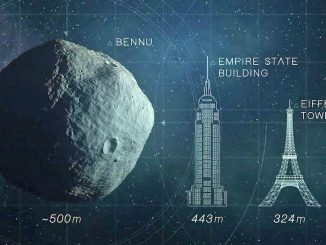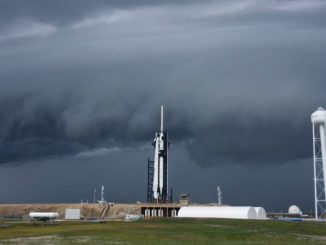
Rocket Lab successfully launched five small satellites from New Zealand Saturday for customers in the United States and Australia, including a CubeSat with a novel swarm of tiny magnetometers to measure the plasma currents that shape colorful auroras.
The 55-foot-tall (17-meter) rocket took off at 0512:12 GMT (1:12:12 a.m. EDT) from Rocket Lab’s privately-operated spaceport on Mahia Peninsula, located on the eastern coast of New Zealand’s North Island.
The light-class rocket lifted off at 5:12:12 p.m. local time, or shortly after sunset Saturday at the New Zealand launch base.
The two-stage rocket, boosted by nine kerosene-fueled engines, climbed through a cloudy sky and arced downrange over the Pacific Ocean before jettisoning its first stage two-and-a-half minutes into the mission. A single second stage engine ignited to continue the climb into orbit, and the rocket released its aerodynamic nose cone and spent battery packs for the electrically-powered engine’s turbopumps.
Around nine minutes after launch, the Electron’s second stage shut down its engine, and a Curie kick stage separated to prepare for a planned 96-second firing to inject the mission’s five payloads into a polar orbit a few hundred miles above Earth.
Rocket Lab confirmed deployment of all five satellites a little more than an hour into the mission.
“All satellites deployed, perfect orbit!” tweeted Peter Beck, founder and CEO of Rocket Lab, a U.S.-based launch company with factories in Southern California and Auckland, New Zealand.
The mission Saturday marked the 12th flight of an Electron rocket since its debut in 2017.
Rocket Lab named the mission “Don’t Stop Me Now,” in honor of a company board member and avid band of the rock group Queen who recently died.
The mission was previously on track to launch March 30, but Rocket Lab paused launch operations after the government of New Zealand ordered most businesses closed and urged people to stay at home in an effort to combat the spread of the coronavirus pandemic.
After the government lifted the work restrictions, Rocket Lab resumed preparations for the Electron launch and was ready to send the five satellites into space Thursday. But high winds kept the rocket from launching, and Rocket Lab waited until better weather was in the forecast Saturday.
Rocket Lab did perform a re-entry test of the Electron rocket’s first stage on Saturday’s mission.
Engineers staged guided re-entry experiments on the first stage during the Rocket Lab’s two most recent launches, demonstrating the booster could survive a plunge back through the atmosphere after releasing the Electron’s second stage and satellite payloads to continue into orbit.
The Electron boosters on those missions — which occurred in December and January — carried guidance and navigation equipment, an independent S-band telemetry system, an on-board flight computer and sensors to gather data during the stage’s re-entry back into the atmosphere.
Rocket Lab aims to recover future Electron first stages, beginning as early as the 17th Electron flight scheduled later this year. After initial efforts to recover the stage after parachuting into the sea, Rocket Lab eventually wants to catch boosters by helicopter as they drift toward the ocean under a parafoil.
The reusability program is aimed at helping Rocket Lab achieve a faster launch cadence, alleviating pressure on the company’s manufacturing infrastructure.
Three of the payloads on today’s Electron launch were designed, built and will be operated by the National Reconnaissance Office, the owner of the U.S. government’s spy satellite fleet. The NRO secured the launch of the three satellites on a Rocket Lab Electron rocket through the NRO’s Rapid Acquisition of a Small Rocket, or RASR, contract vehicle.
The previous Rocket Lab mission in January also carried an NRO payload into orbit on a dedicated flight for the U.S. spy satellite agency. No details about the NRO’s smallsats launched Saturday have been released.
The other payload on Saturday’s mission was developed at the University of New South Wales campus at Canberra in Australia. The M2 Pathfinder mission is managed in partnership with the Australian military to test communications and reprogrammable software-based radio technology in Earth orbit.
Boston University’s ANDESITE mission is part science project, part technology demonstration, with a goal of collecting data on magnetized currents coursing through satellite pathways in orbit. The currents drive the auroras over the Earth’s poles, and play a crucial role in space weather powered by the fluctuating stream of charged particles emanating from the sun.
Comprised of a six-unit CubeSat mothership, called the “Mule,” the ANDESITE mission carries eight smaller sensor nodes to be released into space to collect measurements giving scientists a three-dimensional view of the ever-changing fine-scale structure in the plasma currents.
The sensors plates, each about the size of a slice of bread, each host a magnetometer and a tiny radio transmitter to send data back to the ANDESITE mothership for downlink to a ground station.
“They’re going to form a wireless sensor network in space, very similar to technologies that are used down here in Earth,” said Joshua Semeter, a professor of computer and electrical engineering at Boston University, and an advisor on the student-built ANDESITE project.
“All we’re doing is translating this tech into the space environment for what we think is the first time,” Semeter said.
“The science goal is to use the magnetometer deflections to map out small-scale variations in the current systems flowing in the magnetized plasma that surrounds the Earth,” Semeter wrote in an email to Spaceflight Now.
“These currents are the invisible energy source powering the aurora and driving many other space weather effects, such as atmospheric heating that affects satellite drag, and the formation of small-scale variability in the ionosphere that disrupt communication links and degrade satellite navigation systems,” Semeter wrote.

Semeter told Spaceflight Now the ANDESITE spacecraft won’t be able to release its sensor nodes until the satellite naturally falls below an altitude of about 250 miles (400 kilometers), below the orbit of the International Space Station. That will ensure the tiny satellites, which may be too small to be reliably tracked by ground-based radars, do not threaten the station or the astronauts on-board.
ANDESITE launched into a higher orbit than required for its mission due to the requirements of Rocket Lab’s other customers on the launch.
“So there will be a substantial delay before initiating the main objective of creating a space-based magnetometer network,” Semeter wrote.
While waiting for the proper conditions for release of the sensor nodes, Semeter said the ANDESITE team will begin collecting science data from the mothership for analysis in collaboration with ground-based facilities, such as auroral cameras and radars in Antarctica.
ANDESITE’s acronym is a mouthful. It stands for Ad-Hoc Network Demonstration for Extended Satellite-Based Inquiry and Other Team Endeavors. Developed with support from the U.S. Air Force, ANDESITE was selected for launch by NASA’s Educational Launch of Nanosatellites, or ELaNa, program.
Once the sensor plates are released, they will form a mesh network, each acting as a node to collect data and relay the measurements to the ANDESITE mothership, which is the network’s central hub. The satellite team predicts the network will operate at least two weeks until the nodes eventually drift out of radio range of the mothership.
“With a two-week minimum duration, ANDESITE is obviously not intended as a long-term monitor,” Semeter told Spaceflight Now.
Developed under a low budget, the ANDESITE mission is a pathfinder for future missions that could use the network scheme to study space weather, or collect data in pursuit of other science goals.
“Capturing even one case of structured current patterns overlying an auroral display observed from the ground would provide substantial scientific yield, and proof-of-concept for future, more capable, missions of this type,” Semeter wrote.
Missions with a distributed network like ANDESITE won’t replace traditional large scientific satellites, but the technology could pave the way for new discoveries.
“If you start to imagine a situation where you’re making these measurements from — if it works well — maybe 1,000 locations in space all at the same time, then you have a capability that cannot be produced by a larger monolithic satellite mission,” Semeter said in a Boston University promotional video describing the ANDESITE mission.
Email the author.
Follow Stephen Clark on Twitter: @StephenClark1.



